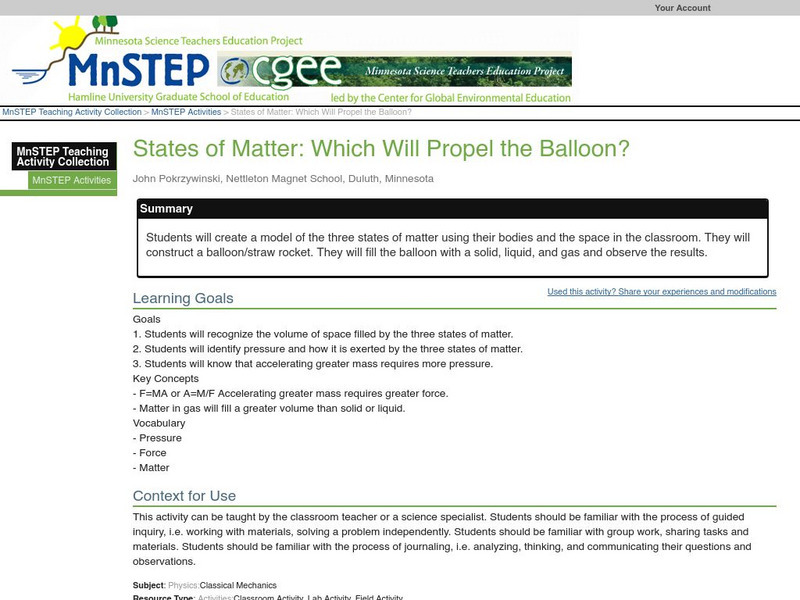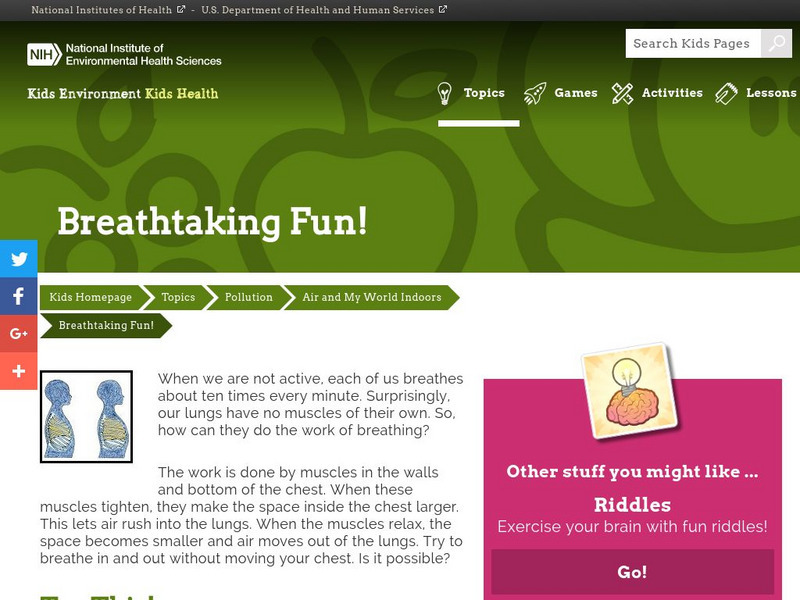BiologyWise
Biology Wise: What Causes Growth of Bread Mold and How to Prevent It?
Explains what bread mold is, what causes it to grow on bread, factors that contribute to its growth, and how to prevent its growth. Includes an experiment for growing mold on bread.
Science Bob Pflugfelder
Science Bob: Make a Static Powered Dancing Ghost
Detailed instructions for making a static powered dancing ghost using common supplies.
Museum of Science
The Atoms Family
Let this classic family of monsters guide you as you learn about energy. Interactive exercises, experiments, and demonstrations help to build knowledge and raise questions.
Educaplus (Jesús Peñas Cano)
Educaplus: Ley Del Pendulo
What determines the period of oscillation of a pendulum? Try this little demonstration to find out the answer.
US Environmental Protection Agency
Epa: Thirstin's Water Cycle Activity [Pdf]
This resource presents a simple set of instructions for building a model of the water cycle in a lidded jar.
Science Education Resource Center at Carleton College
Serc: Mn Step: States of Matter: Which Will Propel the Balloon?
For this activity, learners take part in a simulation of the three states of matter where they role play being molecules. They then create simple balloon rockets and must explain why a gas is the only state of matter that can cause the...
Center of Science and Industry
Cosi Columbus: Paper Cup Anemometer
Make your own anemometer like meteorologists use to measure the speed of wind. Includes full list of materials, procedures, and scientific explanation of what makes wind.
National Institutes of Health
Niehs: Breathtaking Fun
Learn how your lungs help you breathe by making a model of the way your lungs work using a clear plastic bottle, scissors, and two medium-sized balloons.
Center of Science and Industry
Cosi Columbus: Boomerang
Students will make and fly boomerangs and discover that their spinning action is what makes them return to the thrower. Includes full list of materials, procedures, and scientific explanation of "gyroscopic precession".
Educaplus (Jesús Peñas Cano)
Educaplus: Calorimetria [In Spanish]
Practice with the calorimeter and calculate the specific heat of different substances.
Educaplus (Jesús Peñas Cano)
Educaplus: Transformaciones Termodinamicas [In Spanish]
Observe the difference between the isobars, isotherms, adiabatic, and isocore transformations.
Educaplus (Jesús Peñas Cano)
Educaplus: Dinamicas De Dos Masas Que Cuelgan De Una Polea [In Spanish]
This is a short demonstration to see the dynamics of two masses connected by a pulley.
Bill Nye
Bill Nye: Temperature Time Warp
In this activity, learners explore the behavior of cold-blooded animals by observing what happens when they change a fly's temperature.
Curated OER
Science Kids: Science Images: Petri Dish
A close up photo of an empty petri dish used for science experiments.
National Center for Ecological Analysis and Synthesis, University of California Santa Barbara
Nceas: Scientific Method
This concise site from NCEAS contains an explanation of the scientific method along with a basic example of the scientific method in action.
Other
Cern: The Compact Muon Solenoid Experiment
The Compact Muon Solenoid Experiment (CMS), an LHC experiment, detects muons, electrons and photons, provides momentum measurements, and, like ATLAS, is responsible for detecting the Higgs boson. This CERN website offers news about CMS,...
Other
Cern: Experiments
Read about the six experiments at the Large Hadron Collider: ALICE (A Large Ion Collider Experiment), ATLAS (A Toroidal LHC ApparatuS), CMS (Compact Muon Solenoid), LHCb (Large Hadron Collider beauty), TOTEM (TOTal Elastic and...
abcteach
Abcteach: Experiments
[Free Registration/Login Required] Elementary students learning to do experiments will be able to use these ready-made worksheets for gathering data on evaporation, melting ice and others.
Other popular searches
- Life Science Experiments
- Egg Science Experiments
- Hands on Science Experiments
- Space Science Experiments
- Food Science Experiments
- 5 Minute Science Experiments
- Simple Science Experiments
- Air Science Experiments
- Fun Science Experiments
- Earth Science Experiments
- Science Experiments Units
- Sea Life Science Experiments




![Epa: Thirstin's Water Cycle Activity [Pdf] Activity Epa: Thirstin's Water Cycle Activity [Pdf] Activity](https://content.lessonplanet.com/knovation/original/42177-3463950814dbad483d30b2fc4d3e1b32.jpg?1661270397)


![Educaplus: Calorimetria [In Spanish] Activity Educaplus: Calorimetria [In Spanish] Activity](https://content.lessonplanet.com/knovation/original/366822-e58f9ef2399b6d28695cbc1d7c604def.jpg?1661772970)
![Educaplus: Transformaciones Termodinamicas [In Spanish] Activity Educaplus: Transformaciones Termodinamicas [In Spanish] Activity](https://content.lessonplanet.com/knovation/original/366823-971322fb111d96f255f8c660d203ed63.jpg?1661772971)
![Educaplus: Dinamicas De Dos Masas Que Cuelgan De Una Polea [In Spanish] Interactive Educaplus: Dinamicas De Dos Masas Que Cuelgan De Una Polea [In Spanish] Interactive](https://content.lessonplanet.com/knovation/original/408860-61c268f12e47634bb4f222f816b18bf7.jpg?1661771905)



